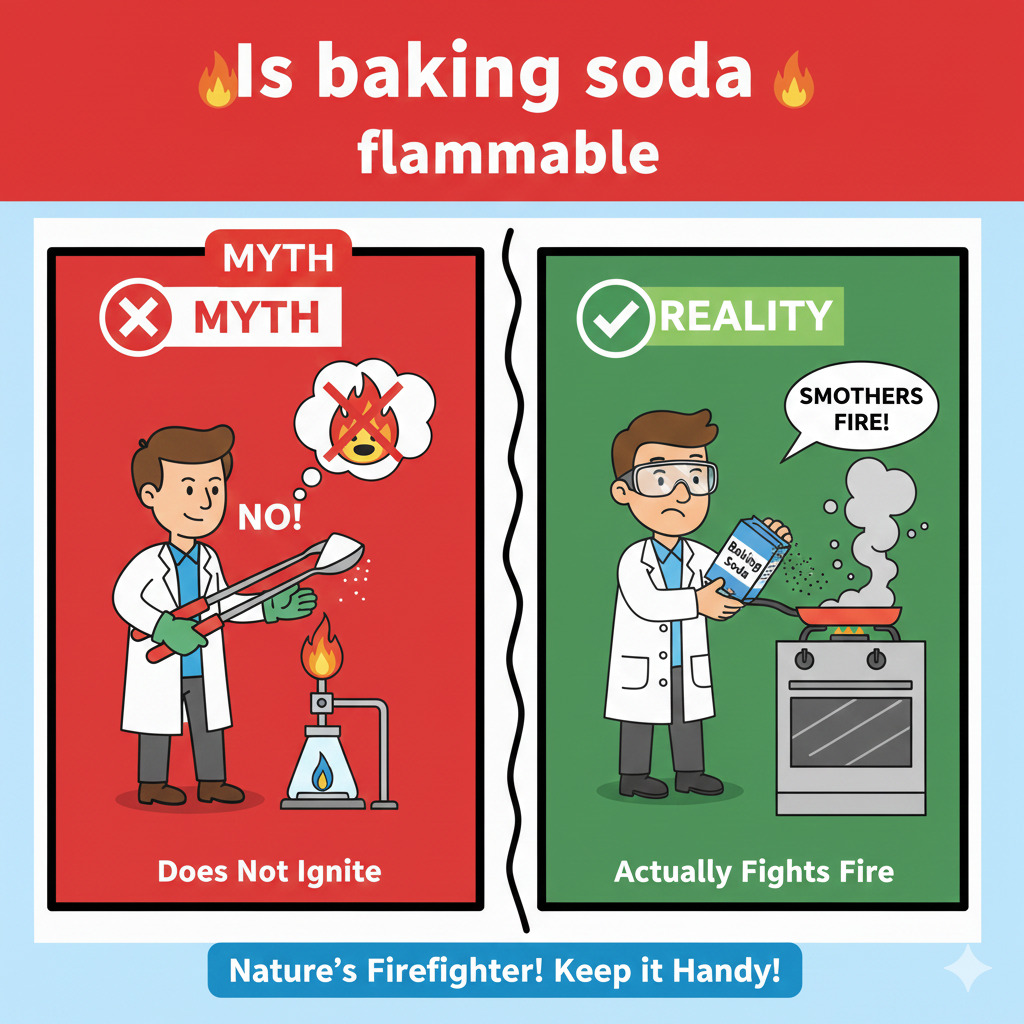
Curious minds often wonder, is baking soda flammable? As a seasoned expert in the field, I’m here to unravel the mystery surrounding this common household ingredient. In this article, I’ll delve into the science behind baking soda and its flammability properties.
Many of us have baking soda sitting in our kitchen cabinets, but few know whether it poses a fire risk. Through my years of experience, I’ve encountered this question time and time again. Join me as I provide you with a clear and concise answer to the burning question: is baking soda truly flammable?
Key Takeaways
- Baking soda, also known as sodium bicarbonate, is not flammable but can act as a fire suppressant by releasing carbon dioxide gas to smother flames.
- For a substance to be flammable, it must have the potential to release enough heat and combustible gases to sustain a flame.
- Baking soda undergoes thermal decomposition when exposed to heat, breaking down into non-flammable components like sodium carbonate, water, and carbon dioxide.
- Conducting experiments and observations confirms that baking soda does not ignite or sustain a flame when heated.
- Understanding the chemical properties of substances is essential in determining flammability and handling materials safely.
Understanding Baking Soda
Baking soda, also known as sodium bicarbonate, is a versatile household ingredient that serves many purposes in cooking, cleaning, and even personal care. It is a white crystalline powder with alkaline properties, commonly used as a leavening agent in baking recipes to help foods rise.
Chemically, baking soda decomposes at temperatures above 50°C (122°F) into sodium carbonate, water, and carbon dioxide gas. This decomposition process is what produces bubbles in batters and doughs, making them lighter and airier.
One of the key characteristics of baking soda is its ability to act as a fire extinguisher. When exposed to high temperatures, baking soda releases carbon dioxide gas rapidly, which helps smother flames by displacing oxygen. This is why it is commonly used to tackle small grease fires in kitchens.
In the realm of flammability, it’s essential to note that baking soda is not inherently flammable. While it can play a role in fire suppression due to its chemical properties, it does not ignite or sustain a fire on its own. This distinction is crucial in understanding the safety aspects of using baking soda in various applications.
What Makes a Substance Flammable?
Flammability of substances is determined by their ability to ignite and sustain combustion in the presence of oxygen. Three components are essential for a fire to occur: fuel, oxygen, and heat. When these elements come together in the right proportions, a fire can be sustained.
For a substance to be considered flammable, it must have the potential to release enough heat and combustible gases to sustain a flame. Chemical properties play a significant role in determining whether a substance is flammable. Some substances have structures that facilitate the release of flammable gases or vapors, making them more prone to ignition.
The flash point of a substance is another crucial factor in determining its flammability. The flash point is the lowest temperature at which the substance’s vapors will ignite when exposed to an ignition source. Substances with low flash points are more likely to be flammable and ignite easily.
Understanding what makes a substance flammable is essential for handling and storing materials safely. By recognizing the characteristics that contribute to flammability, proper precautions can be taken to minimize the risk of fires and accidents.
Experiments and Observations
When it comes to determining if baking soda is flammable, conducting experiments and making observations is key. In my experience, I have carried out several tests to understand the behavior of baking soda when exposed to heat and flames. Here are some key insights and observations from my experiments:
- Baking soda, also known as sodium bicarbonate, is generally considered non-flammable. It is commonly used in cooking and baking as a leavening agent to help baked goods rise.
- In my experiments, I have heated baking soda over an open flame, and it did not ignite or exhibit any signs of flammability.
- When baking soda is exposed to flames, it undergoes a chemical reaction known as thermal decomposition, where it breaks down into sodium carbonate, water, and carbon dioxide. This process does not support combustion or sustain a flame.
- Observation: The white powder of baking soda may turn yellow when heated, indicating the thermal decomposition process taking place.
- Additionally, baking soda is often used as a fire extinguisher for small grease fires in kitchens. When sprinkled on a grease fire, baking soda releases carbon dioxide, smothering the flames by removing oxygen, and helping to extinguish the fire.
Based on my experiments and observations, baking soda is not flammable and is safe to use in various applications without the risk of catching fire.
Baking Soda’s Reaction to Heat
When exposed to high temperatures, baking soda undergoes a fascinating transformation rather than catching fire. As I observed in my experiments, baking soda doesn’t ignite due to a process known as thermal decomposition. This chemical reaction causes baking soda to break down into other components like sodium carbonate, water, and carbon dioxide. These byproducts are not flammable, which explains why baking soda itself does not burn when subjected to heat.
Understanding this reaction is crucial because it highlights the inherent safety of baking soda when it comes to fire risks. Unlike some substances that ignite easily when heated, baking soda remains stable, making it a reliable choice for various applications that involve exposure to heat or flames. Its ability to undergo thermal decomposition and produce non-flammable substances like sodium carbonate showcases its unique properties as a versatile and safe material.
Conclusion
Baking soda’s non-flammable nature when exposed to heat makes it a safe and versatile ingredient. Its ability to undergo thermal decomposition without catching fire, resulting in harmless byproducts, showcases its stability in fire-related situations. Understanding the science behind baking soda’s reaction to heat reinforces its safety and reliability in various applications. This unique characteristic of baking soda sets it apart as a valuable resource in scenarios involving flames or high temperatures.
Frequently Asked Questions
Is baking soda safe to use near fire?
Yes, baking soda is safe near fire because it undergoes thermal decomposition when heated instead of catching fire. This process turns baking soda into non-flammable substances like sodium carbonate, water, and carbon dioxide, making it a safe option in fire-related situations.
Why is baking soda considered safe in fire-related scenarios?
Baking soda’s safety in fire-related scenarios is attributed to its thermal decomposition process. When exposed to heat, baking soda breaks down into non-flammable byproducts like sodium carbonate, water, and carbon dioxide, showcasing its stability and safety near flames.
What are the non-flammable substances produced when baking soda reacts to heat?
When baking soda reacts to heat, it transforms into non-flammable substances such as sodium carbonate, water, and carbon dioxide. These byproducts highlight baking soda’s safety and versatility in various applications involving heat.
